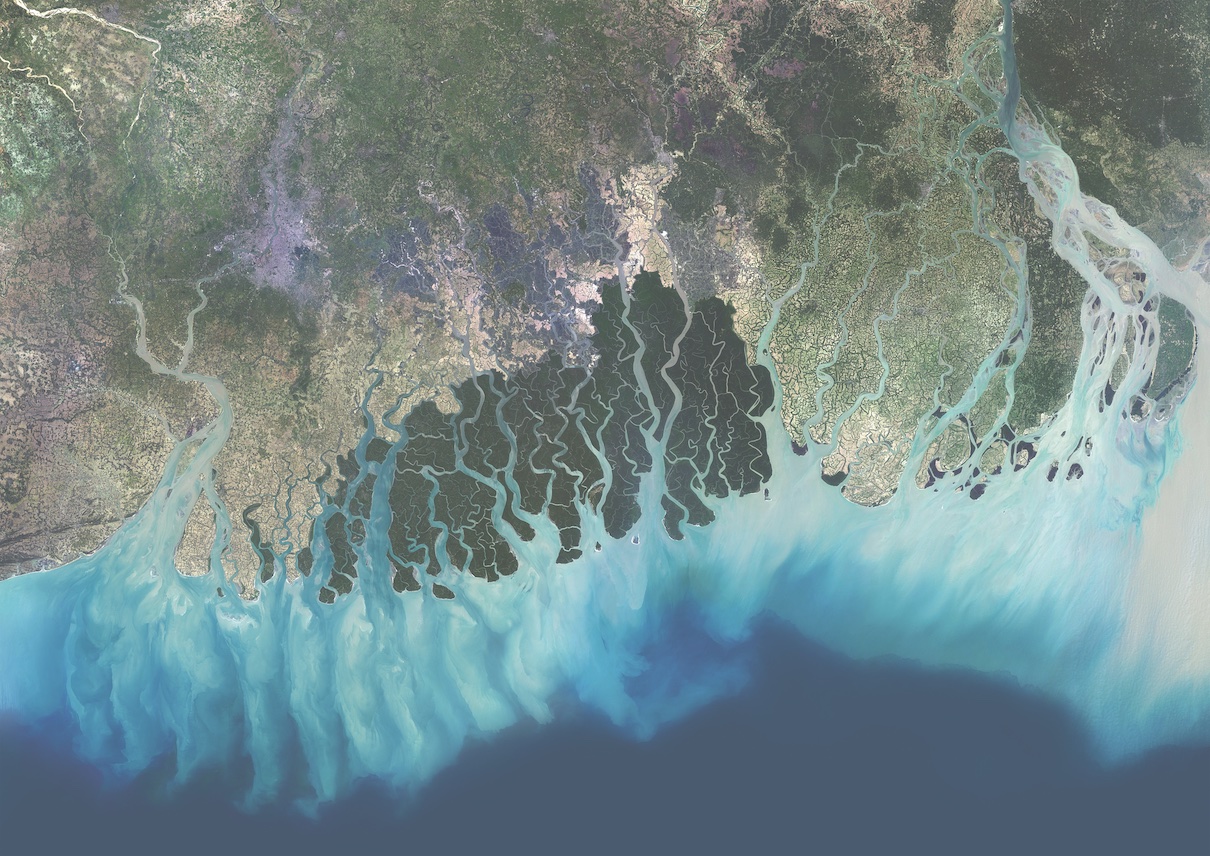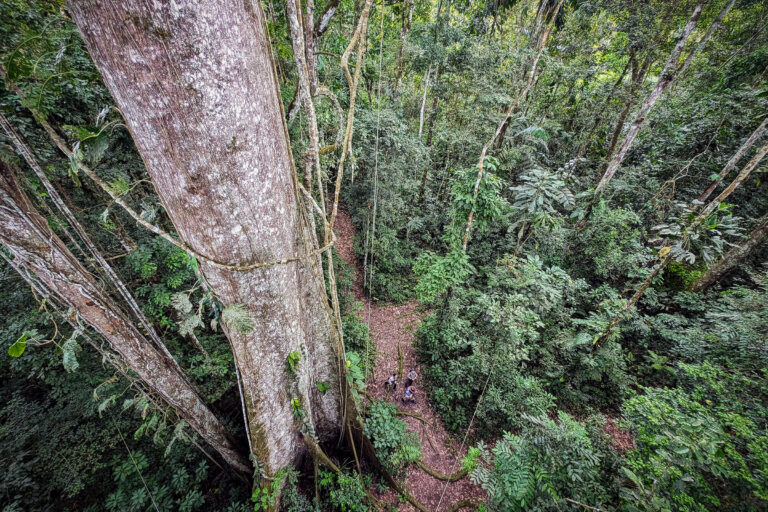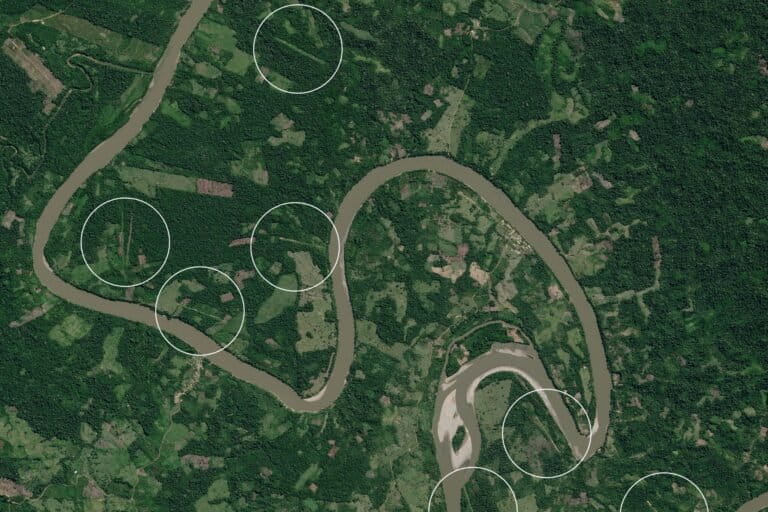- The third edition of Waves and Beaches, published in March 2021 by Patagonia, examines the dynamic relationship between the sea and coast, blending lyrical prose with the theoretical study of beaches, waves and other oceanographic features.
- This new version of the book, which was published 57 years after the first edition, includes a discussion of how human-induced climate change is altering the dynamics between the sea and land, as well as the possible solutions to protecting coastlines against rising sea levels.
- The book was published as a collaboration between oceanographer Kim McCoy and the late Willard Bascom, the author of the first two editions, who acted as McCoy’s mentor in the years before his death in 2000.
Sit on a beach and watch the waves. If powered by a storm, the waves may chew away at the beach, depositing sediment in an underwater sand bar that actually protects the coastline from the ocean’s full strength. But the soft waves that follow a storm will slowly return the sand back to the beach.
This push and pull between the sea and land is at the heart of a book called Waves and Beaches by Kim McCoy and Willard Bascom, which was published as a third edition this year by Patagonia. The book delves into the complex relationship between the sea and different natural forces, including winds, earthquakes and the gravitational pull of the moon and Earth. It also talks about how human-induced climate change is altering the dynamics between the sea and land, and the ways we have tried, both successfully and unsuccessfully, to push the rising sea away from our developed coastlines.
At times, the book feels like an oceanography textbook, providing figures and equations to help the reader understand the properties and dynamics of waves. At other moments, the book reads like a piece of lyrical prose, especially the italicized anecdotes spliced through the text. For instance, in a chapter on shallow-water waves, there’s a small story from McCoy about a “character-building lesson on wave refraction,” or wave bending, which left him stranded on Santa Cruz Island after a hike, and forced him to swim through chilly waters to reach an awaiting dinghy. In another chapter on tides and seiches, McCoy tells the story of free diving through an underwater tunnel beneath the tiny island of Tinetto off the coast of Le Spezia, Italy, which “seiched up and down with the rhythm of the long-period waves.”

Across the book, there are more than 150 color charts, graphs, photographs — some of them taken by McCoy himself — that help illustrate the text. At the end , there are also appendices packed with suggestions for additional reading.
The original edition of Waves and Beaches was published by Doubleday in 1963 by the oceanographer Willard Bascom. McCoy said he first encountered the text while studying oceanography as a graduate student. “I was asked to read this book,” McCoy told Mongabay. “It was a little pamphlet almost.” Many years later, McCoy met and befriended Bascom, who became a kind of mentor to him. Bascom eventually placed the second edition of Waves and Beaches into McCoy’s hands and asked him what the text needed. “That was my transition from being his student to being his collaborator,” McCoy said.
In 2000, Bascom died at 83 after being struck by a car. A few years later, Bascom’s daughter, Anitra, asked McCoy if he would be interested in publishing the third edition of Waves and Beaches, McCoy said. The resulting book, published in March 2021, is a blend of Bascom’s original text with McCoy’s own words.
“I’ve kept the core — how waves are formed, how they propagate across the ocean, and how they get rid of their energy — but I’ve added a golden thread of climate change,” McCoy said.

Climate change is indeed a prominent theme throughout the book. There’s a chapter devoted to the many problems generated by climate change, from melting sea ice to rising sea levels. But the book also looks at solutions people have tried to deal with the changing dynamics of the sea, including sea walls, jetties, groins, breakwaters, and even storm surge barriers. Some places in the world have successfully applied these solutions, but others have not. In some instances, what’s touted as a solution may have just displaced the issue of damaging waves.
As the authors write in the book, “The first and most valuable lesson one can learn about the sea is not to underestimate it.”
While the sea is shown to be a formidable force capable of reshaping coastlines, and subsequently reshaping lives, Waves and Beaches takes a celebratory approach toward the ocean. McCoy suggests that one of the most powerful things a person can do to understand the dynamics of sea and land is to spend time on the coast.
“Go and see for yourself because nature is part of us, we are part of nature,” he said. “And when we respond, we resonate with things that nature has been trying to tell us.”
Mongabay spoke with McCoy in June. This interview was edited for length and clarity.

Mongabay: How did your passion for the ocean begin?
Kim McCoy: It began before I can remember. By the time I was 5, I had already crossed the Pacific twice, the Atlantic once, and was living on the Mediterranean. When I was about 9, I started body surfing seriously, and then I started free diving at age 11. And at 13, I was a certified tank diver, you know, scuba diver, and I started sailing then. And then fast-forward a few years and I ended up going to university, studying math and physics, and then oceanography in graduate school. So, I’ve traveled all over the world, been to all seven continents, and I’ve been to six of them by sea.
Mongabay: Your new book, the third edition of Waves and Beaches, was a collaboration with the late Willard Bascom. Can you tell me about that process, and also how the book has evolved since its initial release?
Kim McCoy: When I was studying oceanography in graduate school, I was asked to read this book, which is the first edition of Waves and Beaches. It was a little pamphlet almost. And when I was attending a meeting of the Deep Submersible Pilots Association, Willard Bascom was the speaker and he was talking about shipwrecks — underwater shipwrecks. I went up to him after his talk to thank him, and he said, ‘Well, I’m not really looking for these modern shipwrecks. I’m looking for a bronze from the age of Pericles. And [I thought], ‘Willard Bascom is a lot more than just writing about waves and beaches.’ And so we became friends in the late ’90s, and for several years, we interacted quite frequently, sort of like father and son. He lived just around the corner from where I live now.
He would give me homework and things to do and things to read and we’d discuss things. And then one day, he handed me the second edition of Waves and Beaches, maybe after a year or so after I’d known him, and said, ‘Tell me what it needs.’ And that was like, ‘Uh oh, Willard Bascom’s asking me to read his book Waves and Beaches and tell him what it needs?’ So I guess he had some level of respect for my knowledge. I read it and gave my suggestions and he liked it. That was my transition from being his student to being his collaborator. Unfortunately, just a couple months after that — he had just received the rights from Doubleday — he was hit by a car and died. So Willard Bascom passed away in the year 2000. A few years after his passing his daughter Anitra asked me if I wanted to do the third edition because she knew I was interacting quite a bit with her father. And so I said, ‘Sure.’ And so this is the last homework assignment of Willard Bascom for me.

Mongabay: How much of the text changed in this third edition?
Kim McCoy: The most difficult part of doing this third edition was keeping Bascom’s wonderful style. The book sold half a million copies during the two editions. He had a very wonderful, mellifluous voice, and he wrote really well. The [second edition] has about 90,000 words in it. In this new book, I tried to keep the words to about the same — it also has about 90,000. I don’t know exactly how many are mine, but somewhere between 25 and 40%. I’ve kept the core — how waves are formed, how they propagate across the ocean, and how they get rid of their energy — but I’ve added a golden thread of climate change. So the things that are significant for people today — weather patterns, changing sediment rates, the global web of commerce now being on container ships — all that has [been added], yet every single one of those interacts with the waves and the sediment movements that the waves and tides cause.
Mongabay: How is climate change transforming our oceans and beaches, and changing the world that we all inhabit?
Kim McCoy: Sea level has risen by about 15 centimeters [6 inches]. Now, that doesn’t sound like a whole bunch, but if you have a slope that is one in 100 [1% gradient], it’s going to go in[land] 15 meters [50 feet]. The legal definition of where your land ends if you own coastal land is where the low, low water [lies] — it’s a tidal datum. And that actually is now going in. So the people will lose their property rights, their gas and oil jurisdictions, they lose a whole bunch of things. And this is not fictitious, but there have already been legal cases [involving] people who lose their property because of sea level rise.
Let’s look at the country of Indonesia. What’s happening is Jakarta is sinking because of a couple things — one is sea level’s rising, and the other thing is they’re pumping fresh water out of the ground, which causes the land to sink. And then they’ve built barriers — about 20 kilometers [12 miles] of barriers to protect Jakarta — and they’ve realized it’s futile. So there’s a national effort now on to relocate the capital of Indonesia. That’s very significant.
If you look at the Mississippi River Delta, there are big problems from not only pumping fresh water out from the freshwater aquifer, but there’s also problems of saltwater intrusion. So that water table is dropping, and then the saltwater goes, ‘Oh, I’m going to come in here,’ so it renders the freshwater less [potable]. And in many areas, it’s no longer even fit for crops. So the sea level rise is encroaching upon the coastal freshwater aquifers. It’s affecting low-lying cities. The city of Miami is spending $500 million on additional pumps.

Mongabay: Do you think that humans have consistently underestimated the power of the ocean, especially when it comes to coastal developments?
Kim McCoy: One of the most amazing examples of humans underestimating the power of the sea is a place up in Oregon called Bayocean. Bayocean, Oregon, was started around the year 1900. And the guy who developed it wanted to have an Atlantic City West. And what he did was sell plots. He divided Bayocean into about 2,000 lots, and everyone went to this sandspit in North Central Oregon. It had trees and everything. They had a theater that could take 1,000 people, they had a big pool. In the summers, several thousand people would flock to Bayocean. In around 1912 or so they convinced the Army Corps of Engineers to build a jetty. But it changed the wave dynamics and it started eroding the base of Bayocean. And it all fell into the sea. Everything. All the houses, the theater, the swimming pool, and it ceased to exist around 1960. Now later on in the ’70s, they convinced the Army Corps of Engineers to build a second jetty. And they did, and then the sand came back. But now it’s a park — a state park. I was there, actually, not too long ago. So that’s a massive underestimation of the power of the sea.
We are terribly underestimating the interaction of the watershed and its significance in the coastal zone. As weather patterns change, the amount of sediment changes. If it’s raining more, you’re going to get more sediment. If it’s raining less, you’re going to get less sediment. And with that comes either beach formation, delta formation or erosion. So that dynamic on the coastal zone is really where the battle of climate change is going on. It’s at the edge of where the sea meets the land, and that’s waves and beaches. So what happens way upstream in, you know, Oklahoma or South Dakota, influences what happens in the Mississippi. What happens in South Oregon affects what happens in the northern coast of California. So these are transborder issues on a national level, and they’re international issues as far as climate is concerned. Rain and the meanders of the jet stream don’t know where the border is, so these things are significant to everybody on Earth.
Mongabay: Do you think some of the current solutions to sea level rise, such as seawalls and jetties, will continue to be adequate? Or do you think we need to be looking at other types of solutions?
If one is on bedrock, so to say, a seawall should be adequate if the slope in the coastal zone is very steep. However, if you’re in Galveston on the south coast of Texas, or you live in the Netherlands, it’s not adequate. Now the Delta Works in the Netherlands is a massive project, and they’re taking a national approach to it and a global view. And you can protect against coastal erosion if you have a national approach. However, the national approach also includes areas that just need to be given up to the sea.
So Galveston, in the year 1900, had the most costly national disaster in the U.S. in terms of lives lost. I think 6,000 or 7,000 people died in Galveston — that’s on a barrier island. It is difficult to protect barrier islands. Changing weather patterns affect sediment flows, while upstream away from the coast, unknown amounts of freshwater usage, sand mining and dike construction affect the health of barrier islands. Change brings either too much sand — bad for harbors — or too little sand — bad for berms, beaches and sandbars. A storm surge can wash away part of a barrier island. There is an image in the third edition of Waves and Beaches of Hatteras Island, North Carolina. It was breached by a 3-meter-plus (10-foot-plus) storm surge in 2003. Roads and buildings were swept away. No amount of coastal protection, barriers or anything short of what the Dutch are doing, would have stopped that. For such things we need a national coastal policy.

The way to circumvent that is very easy. You just don’t build there. I’ve talked about that in the book. You should simply not permit [housing in] the floodplains. FEMA is redefining floodplains. But what happens is, you live in a municipality, you suggest to FEMA that the floodplain needs to be changed, and FEMA changes their map, and then your insurance rates go up. So there’s not a positive feedback there, because the people that live in low-lying areas don’t want their insurance to go up. So it needs to be a top-down [approach] where ‘OK, what we’re going to do is purchase the houses,’ and many municipalities have purchased hundreds, if not thousands, of houses in low-lying areas, so that the houses are no longer in jeopardy, the structures that we’ve built erroneously in low-lying areas that are subject to not only floods from rivers, but storm surge from the sea, that they’re no longer in harm’s way.
Mongabay: Now you talk about the Delta Works as a successful way to deal with storm surge. Do you think we need to be building similar structures in other parts of the world?
Kim McCoy: There has been actually. The Russians built one in the Baltic [Sea] to protect Saint Petersburg. But before you build the structure, you need to have the national policy [to support it]. The way the Dutch have done it I think is quite wise. They said, ‘OK, if we get sea level rise of just 1 meter,’ and this is from any purpose — from storm surge, from sea level rise, from climate change, from rain from the land — all these things can change the level of the water. So with a 1-meter [3-foot] water change, how much damage do we assess will happen? And they got the number, they said, ‘OK, alright, it’s going to cost 100 million euros of damage. So we can probably spend up to 100 million euros, and still be cost effective.’ [Editor’s note: McCoy offered this figure as a hypothetical case, not the actual cost.]
Hurricane Katrina in 2005 caused something like 80 billion euros [$99 billion] worth of damage, not to mention over a thousand people that died. Some areas of New Orleans were never reinhabited. In comparison, the Maeslantkering, part of the Dutch Delta Works project, was built to protect Rotterdam, it cost about 500 million euros [$600 million]. Spending 500 million to save losses of 50 billion is a no brainer. If you were going to invest in the stock market, in something that could get you 100 times return on your money in 20 years, I think you would do it. [Hurricane Katrina wasn’t] a 100- or 10-year storm or something. This is something that could happen next year.

Mongabay: Is it a solution to just move away from the coastlines as we move into the future?
Kim McCoy: Not building in low-lying areas is very significant. For instance, in Chile, they’ve had a few tsunamis there, and they built their buildings in the coastal region about 10 meters [33 feet] above land. That’s a pretty big thing — so you see all these buildings on stilts, so if you’re going to rebuild something, build it on stilts. If that’s too expensive, build elsewhere.
But on a large scale, the person that is funding an infrastructure project, you know, international development banks, they should not be allowed to fund things in areas that will not last for 100 years. I talked about that [in the book]. [In the U.S], when you build a structure you depreciate it over 28 or 30 years, which means that on paper that structure is no longer worth anything after that 30-year period. Well, maybe it would be wiser to build things where the builder is actually responsible for something for 100 years. So they build it with higher quality. You hear about affordable housing all the time, and I just have to almost laugh because affordable housing is housing that lasts the longest. If the developer were somehow legally tied to having stewardship over that property or being legally accountable for that property for these longer periods of time which now start encompassing climate change and sea level rise, then the people that don’t have a lot of capital in poorer countries wouldn’t end up living in structures that have been financed with no attention toward climate change.
Mongabay: What kind of relationship would you like to see everyone develop with the ocean?
Kim McCoy: If you want people to have a more intimate relationship with the ocean, go and see those things that are in Waves and Beaches in this third edition. Go and see for yourself because nature is part of us, we are part of nature, and when we respond, we resonate with things that nature has been trying to tell us. Unfortunately, large corporate entities and hydrocarbon-based companies are not listening to what nature has been telling us for all of humanity. So go to the coastal zone, go look, go sit at a dock for a while and watch ships come and go. Look at a dredging process going on in a harbor. Look out to sea and watch the waves come in, look at the different types of waves. Watch a storm when a storm is rising. Go sit in the rain and realize that nature is intimately connected, and we are intimately connected with it. So it’s a very simple thing, it’s not a piece of homework, just to go out and be at the coast of the sea. Don’t take your phone. Don’t send texts back and forth to everyone. Just sit and observe. And the longer you sit and observe, the nuances will appear. And there are very, very few people that do not develop an intimate relationship with nature if they spend much time in it.
Banner image caption: The Wedge (Newport Beach, California) is a spot where reflected waves (off the stone breakwater and the backwash down the steep beach) combine with the oncoming waves to produce unpredictable conclusions. Image by Benjamin C. Ginsberg.
Elizabeth Claire Alberts is a staff writer for Mongabay. Follow her on Twitter @ECAlberts.
FEEDBACK: Use this form to send a message to the author of this post. If you want to post a public comment, you can do that at the bottom of the page.














